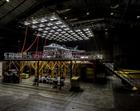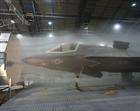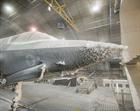Iced lightning for fighter destined for HMS Queen Elizabeth
From Royal Navy
Ice encases the nose of an F-35B Lightning II as the jet undergoes extreme weather testing.
The new joint striker fighter destined for the Royal Navy’s HMS Queen Elizabeth and HMS Prince of Wales aircraft carriers was subjected to temperatures ranging from 120°F to -40°F in a climatic laboratory at Eglin Air Force Base in Florida.
As well as ice, the fight-generation stealth aircraft was tested in wind, solar radiation, fog, humidity, rain, freezing rain, icing cloud and snow.
“While we are testing in the world’s largest climatic testing chamber, we’re pushing the F-35 to its environmental limits,” said F-35 test pilot Billie Flynn, who performed extreme cold testing on the aircraft.
We’re pushing the F-35 to its environmental limits.
Billie Flynn, test pilot
“To this point, the aircraft’s performance is meeting expectations”, Flynn said. “It has flown in more than 100 degree heat while also flying in bitter sub-zero temperatures.
“In its final days of testing, it will fly through ice and other conditions such as driving rain with hurricane force winds.
“We are learning more and more about the aircraft every day. The future warfighters can be confident the F-35 will perform in any condition they find themselves in.”
With 13 countries currently involved with the program, the F-35 must be tested in meteorological conditions representative of those locations from which it will operate, ranging from the heat of the Outback of Australia to the bitter cold of the Arctic Circle above Canada and Norway.
“We’ve designed an environment here at the chamber where we can simulate virtually any weather condition – all while flying the jet at full power in either conventional or vertical takeoff mode,” said Dwayne Bell, McKinley Climatic Laboratory technical chief.
The aircraft was taken to Eglin from the F-35 Patuxent River Integrated Test Force in Maryland to the U.S. Air Force 96th Test Wing’s McKinley Climatic Laboratory, which supports all-weather testing of weapon systems to ensure they function regardless of climatic conditions.
Since December 2006, the F-35 Lightning II has surpassed 25,000 combined flight hours with 16,200 hours in the F-35 military fleet aircraft and 8,950 hours of System Development and Demonstration (SDD) testing.
To date, 158 F-35 pilots and more than 1,650 engineers have graduated from training at Eglin AFB. The F-35 has completed multiple weapons tests as well as F-35B and F-35C first-life durability testing.
Additionally, the test fleet has conducted two F-35B sea trials aboard the USS Wasp , and last November the F-35C completed its first sea trial aboard USS Nimitz.



